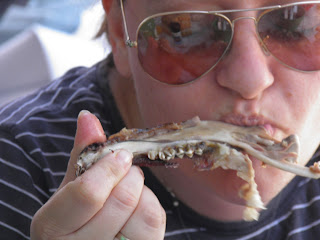May Day or Protomagia in Greek
1st May is another holiday in Greece, for schools and workers. Also a time for strikes, protests and demonstrastions in the middle of Athens.
It is a workers holiday, Labour Day in other countries, and a day to celebrate Spring. When the children were young we always went on a picnic, along with crowds of other Greeks doing exactly the same, and made a May Wreath of wild flowers to hang over our front door.
Everything will be closed except of course cafeterias, tavernas and cheese pie and sticky cake shops.
This year it falls on a Monday so we have another long weekend. Poros is full again and Monday we'll have a huge influx of day trippers.
We pick daisies, poppies and other wild flowers, roses from our garden and any flowers we can pilfer from the neighbours' front yards. A head of garlic or an artichoke bring good luck.
Daughter Danae cuts a supple olive branch or some grapevine and joins it in a circle. Then the flowers are woven around the stefani (wreath) and tied in place with string.
We usually tie a bunch of wild flowers to the front of the car or bike as well.
It is left there till
June 24th
Summer Solstice
the fiesta of St John
Midsummer
when the wreath is burned on a fire ideally lit at a crossroads.
The celebration of Spring and flowers comes down to us from the story of Dimitra (the greek goddess of harvest/ fertility of the earth) and daughter Persephone.
Pagans, the Orthodox Church or the 12 Gods of Ancient Greece. Take your pick.
Chamomile
When we visited the garden centre last week the whole area was awash with yellow and white chamomile. The air was full of the refreshing scent of this carpet of herbs. My sister in law picks bags of chamomile and lays it out in the sun for a few days to dry it out and then stores it in a clean pillow case. She gives us jars of the dried herb whenever we need some to calm a nervous stomach or an agitated mind.
Kala Protomagia
The poppy (paparouna). Sacred to Dimitra and Hypnos, the God of Sleep (....and opiates)
NB Note very well. There was no mention of food in this post (except for a passing reference to picnics and sticky cakes)










































































.jpg)















